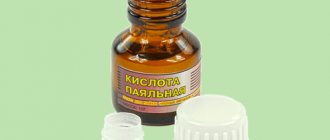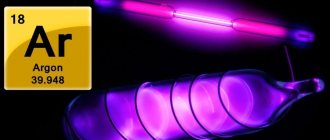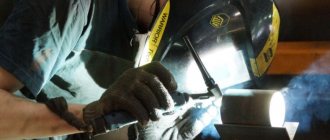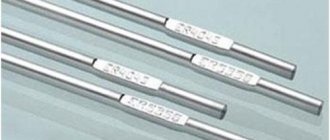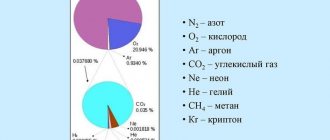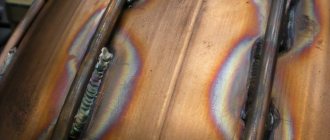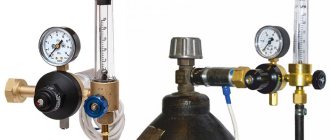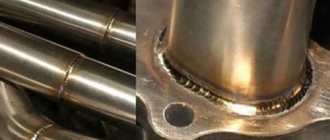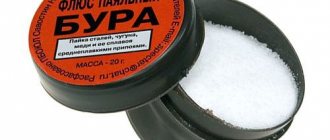Physiological effect of argon on humans
The effect of argon on the human body is due to its ability to fill the lower and middle sections of the lungs, displacing oxygen, which leads to oxygen starvation of organs and tissues, and in severe cases causes attacks of suffocation and death.
The effect of argon begins to manifest itself when it accumulates in a room above 4% of the air volume. Short-term inhalation of argon in high concentrations (over 15% of volume) causes:
- nausea;
- vomiting;
- dryness in the nasopharynx, eyes;
- loss of consciousness.
With a longer exposure to argon in a small concentration, lacrimation, coughing, increased pulse and heart rate occur with a simultaneous decrease in systolic (upper) blood pressure and the appearance of pressing pain in the chest.
If an increase in argon concentration in a workspace occurs simultaneously with a decrease in oxygen levels, workers may experience tinnitus, headaches, and rapidly progressive fatigue. When speaking, wheezing occurs, and the skin of the face and limbs acquires a bluish tint.
Symptoms of argon exposure on the body are similar to the physiological signs of an excess of nitrogen in the air, but a specific sign of argon exposure is a feeling of euphoria that goes away when moving to fresh air.
First aid
If workers exhibit symptoms of prolonged exposure to small concentrations of nitrogen, it is necessary to take the victim out into the open air, provide rest and plenty of warm, sweet drinks. If there are signs of exposure to argon in high concentrations (loss of consciousness, wheezing), perform the following actions:
- The victim is taken out into the fresh air.
- Take off tight clothes, unfasten the collar and trouser belt.
- Perform artificial respiration.
- They call an ambulance.
If it is impossible to quickly remove a person poisoned by argon into the air, you should ventilate the room as much as possible - open and secure all windows and entrances. It is important to prevent further filling of the room with argon - tighten the taps on the cylinders and call the gas service.
When performing artificial respiration, it is desirable to provide additional access of oxygen to the victim’s respiratory system, for which medical oxygen pillows are used, and in their absence, oxygen can be pumped through a gas outlet hose from industrial cylinders for welding. It should be remembered that before pumping oxygen from a cylinder, you need to make sure that there are no oily rags or flammable substances within a radius of 15 meters from the victim.
If a person has been exposed to welding argon for more than 2 hours, he needs to receive artificial ventilation in the hospital to prevent complications. The person providing assistance must record the start time of first aid and inform it to the emergency doctors.
It is important to note that when evacuating victims from a closed room filled with argon, rescuers need to use hose gas masks or an isolated oxygen supply system.
Dependence of argon pressure in a cylinder on temperature
As it heats up, the pressure of the gaseous substance in a closed volume increases. The table shows approximate pressure values in the cylinder depending on the ambient temperature.
| T, °C | P, Megapascal |
| -40 | 10,45 |
| -30 | 11,33 |
| -20 | 12,21 |
| -10 | 12,92 |
| 0 | 13,74 |
| +10 | 14,62 |
| +20 | 15,33 |
| +30 | 16,03 |
It should be borne in mind that the balloon pressure does not change instantly, but as it warms up or cools down.
Preventing the effects of argon
The harmful effects of argon during welding can be prevented by using the following measures:
- ensuring active ventilation of rooms for welding work;
- use of oxygen level monitoring devices;
- regular checking and maintenance of argon cylinders;
- regular sampling and analysis of air samples when working in mines and basements;
- use of oxygen-isolating breathing masks;
- compliance with the work and rest regime.
For active ventilation of workshops, you can use fans and industrial air conditioners; when planning their location, it is important to determine in advance possible places where argon will accumulate if it leaks. Oxygen level monitoring devices with sound and radio alarms should be installed no higher than 0.5 m from the floor level near each point where welding work is carried out with a separate argon cylinder.
If welding work is carried out in hard-to-reach underground rooms, then air samples must be sent for analysis at least 3 times per work shift (12 hours) and if an increased concentration of argon is detected, personnel must be evacuated immediately.
Individual breathing systems that isolate the worker from the external atmosphere should be used when welding alone in hard-to-reach places where it is impossible to provide first aid to the victim or assess the degree of suffocating effects of argon (for example, when repairing ventilation shafts).
Maintaining a rest regime and going to the first aid station at the first signs of dizziness and lack of oxygen will help avoid loss of consciousness and suffocation.
Technical requirements
Argon gas. Highest grade GOST 10157-79 as amended. 1, 2, 3
| Argon volume fraction | not less than 99.993% |
| Volume fraction of oxygen | no more than 0.0007% |
| Volume fraction of nitrogen | no more than 0.005% |
| Moisture content at normal. conventional | no more than 0.0009% |
| Carbon-containing | no more than 0.0005% |
| Pressure at standard conditions | not less than 15.0 MPa |
Argon gas of high purity TU 6-21-12-94
| Argon volume fraction | no less than 99.998% |
| Volume fraction of oxygen | no more than 0.0002% |
| Volume fraction of nitrogen | no more than 0.001% |
| Volume fraction of water vapor | no more than 0.0003% |
| Volume fraction of CO2 | no more than 0.00002% |
| Volume fraction of methane | no more than 0.0001% |
| Volume fraction of hydrogen | no more than 0.0002% |
| Pressure at standard conditions | not less than 15.0 MPa |
Liquid argon High grade GOST 10157-79 as amended. 1, 2, 3
| Volume fraction of nitrogen | no more than 0.005% |
| Volume fraction of oxygen | no more than 0.0007% |
| Moisture content at normal. conventional | no more than 0.0009% |
| Carbon-containing | not normal. |
Argon gas is transported in steel cylinders (GOST 949-73) of gray or black color under a pressure of 150 kgf/cm². For transportation by road, medium-volume cylinders are placed in special metal containers (pallets).
Liquid argon is poured into special tanks with powder, vacuum-powder or vacuum-multilayer insulation intended for the transportation of liquid argon.
Smoke during welding
Smoke during welding, whether manual arc MMA, TIG, MIG/MAG, or gas, poses a danger to human health. Along with it, various heavy metals and chemical compounds rise, almost a third of the periodic table. Each substance can affect the human body differently. We will talk about the most dangerous ones.
Manganese Mn is used as a metal deoxidizer in metallurgy. Makes metal more liquid and pliable. During a thermal reaction with other metals it rises in the form of small particles. An overdose of 40 mg leads to loss of appetite, drowsiness, memory impairment, and increased fatigue. It is a polytropic poison. Long-term exposure leads to disruption of breathing, the cardiovascular system, the functioning of the brain, and the central nervous system.
Zinc Zn is used as an alloying corrosion-resistant material in brass, the content can be up to 50%. Gives special properties to metal. When burned, white smoke and oxide powder are formed. They cover pipes, sheets and the like. The daily dose should not exceed 11 mg. Overdose leads to deterioration of health. Associated symptoms include: the appearance of a sweet taste in the mouth, nausea, vomiting, severe thirst, chills, increased drowsiness, dry cough, pressing pain in the chest, a sharp increase in body temperature. Long-term exposure leads to oncology of internal organs. Renal failure, impaired circulatory function, heart function, and calf muscle cramps may develop.
Copper Cu metal is used both in pure form and in alloys of bronze, brass, and other metals. It has high thermal conductivity and electrical conductivity. Widely used in industrial sectors and in everyday life. Excess inhalation of copper vapors and particles leads to a functional disorder of the nervous system, copper fever, lacrimation, irritation of the mucous membranes of the respiratory tract, headache, weakness, muscle pain, heavy sweating. Long-term exposure leads to impaired renal function, liver cirrhosis, allergic dermatosis, and anemia. Especially when welding copper and its alloys, such symptoms are observed.
Boron B is used in metallurgy for alloying steels and non-ferrous metals. During the welding process it evaporates, forming various chemical compounds. Signs of poisoning: irritation of the eyes and nasopharynx, convulsions, mental disturbance, double vision, vomiting, nausea.
Nickel NI, when evaporated into the respiratory tract, can reduce lung motility, chronic bronchitis, and lung cancer.
Silicon and Si accumulation in the lungs when inhaling vapors leads to the disease silicosis, associated with difficulty breathing.
Potassium K is used in coating the electrode with silicon. Potassium silicate or liquid glass. If ingested as small particles into the lungs, it can cause serious complications. There is general muscle weakness, more frequent urge to go to the toilet, profuse sweating, and an increased risk of diabetes.
Nitrogen N gas, which is used in welding, when inhaled in its pure form, affects the central nervous system. Side effects of its manifestations such as unreasonable excitement, fear, anxiety, cramps and spasms of the calf muscles, breathing problems, chest pain, tachycardia, hyperthermia, impaired consciousness.
Carbon dioxide CO2 is used as a shielding gas during welding. In a poorly ventilated room, its permissible concentration increases. This affects the human condition. Since it also carries nitrogen along with it. Poisoning manifests itself in the form of impaired coordination of movement, headache, visual irritation to bright light, slow motor skills, and mental fatigue.
Argon gas Ar is used in TIG welding MIG/MAG; it has inert properties and does not interact with metals. Heavier than air. A single inhalation of pure argon causes euphoria. This is accompanied by the displacement of oxygen from the human body and replaces it. With subsequent prolonged exposure, heaviness occurs in the frontal part of the head, a feeling of heat throughout the body, and tingling in the limbs.
Chromium Cr is used in metallurgy for alloying steels of various alloys, electroplating, etc. When ingested in large quantities in the form of particles and chemical compounds, it makes itself felt. Skin rashes, dermatitis, eczema, development of stomach ulcers, bronchial asthma, development of liver kidney disease. Especially when welding stainless, heat-resistant steels.
Iron Fe excess can lead to damage to the brain, kidneys, and liver. Signs of poisoning: yellowish skin tint, heart rhythm disturbances, nausea, loss of appetite, stomach pain.
In addition to gases, all elements interact with each other, enhance the process of absorption into the body, resulting in a critical dose of poisoning. Please use respirators that neutralize impurities in the smoke during welding. Sometimes it does not appear immediately, but only after some time. Let’s say you worked all week and nothing bad happened, but on the weekend at home you already feel tired while resting. At the same time, you do not engage in physical labor. Here is the effect of these elements on the body.
Environmental issues of MIG/MAG welding
Details Details Published 10/24/2015 14:: 3003
The figure clearly shows that, despite the abundance of information about the dangers and harmfulness of welding processes, problems still exist. The operator, with his hands not protected from short-term ultraviolet radiation, demonstrates the operation of the welding head. I'd like to think that behind the scenes there is a welding shield, a local exhaust with air purification, or personal protective equipment against ozone for the operator's respiratory system.
MIG/MAG welding is performed both in carbon dioxide and in protective gas mixtures. The composition of the most commonly used mixtures and process characteristics are presented in Table 1.
Multicomponent gas mixtures containing argon have technical advantages over pure carbon dioxide and are confidently filling the welding technology market. And if the problems of working conditions and safety when welding in argon were previously focused only on defense enterprises, now they face welders in all industries.
The problem of photochemical reactions in the air surrounding the welding arc
More than forty years ago, it was established that the main source of dangerous and harmful factors in gas shielded welding is light radiation from argon ionized in the arc. The short ultraviolet emission peaks of ionized argon occur at 185.0, 194.1, 197.1 and 200.0 nm. This radiation is characteristic of the Sun in outer space. Only rays with a length of 290 nm reach the Earth's surface from the Sun; shorter ones are slowed down by the atmosphere. Absorption of a photon with a wavelength of ~ 100-1500 nm, which corresponds to an energy of 0.8-12.4 eV (80 - 1200 kJ/mol), causes a quantum transition of air molecules and substances contained in it from the ground electronic state to one of excited states, or photoionization - the removal of an electron and the formation of a radical cation, followed by so-called photochemical reactions. (Yu. S. Drugov, V. G. Berezkin. Gas chromatographic analysis of polluted air. - M.: Khimiya, 1981, 256 pp.).
The most active part of the radiation, up to 157 nm in length, is decelerated by air within a radius of 0.5 m from the center of the arc. Radiation with a length of up to 184 nm reaches a distance of up to 1 m and 212 nm reaches a distance of up to 10 m. When short-wave ultraviolet radiation is inhibited, photochemical reactions occur both with the main air gases and with a multicomponent mixture of workplace air pollutants containing many toxic substances belonging to chemical compounds of various classes. Currently, the most studied reactions are with molecular oxygen and nitrogen, with the formation of ozone and nitric oxide.
Ozone - O3, an allotropic form of oxygen, is a powerful oxidizing agent. Unlike the oxygen molecule, the ozone molecule consists of three atoms and has longer bonds between the oxygen atoms. In terms of its reactivity, ozone ranks second, second only to fluorine. Due to its chemical activity, ozone has a very low maximum permissible concentration in the air (comparable to the maximum permissible concentration of chemical warfare agents) of 5·10-8% or 0.1 mg/m3, which is 10 times the olfactory threshold for humans. In other words, if you smell ozone, there is ten times more ozone in the room than is allowed by sanitary standards. Ozone is a gas that is toxic if inhaled. It irritates the mucous membrane of the eyes and respiratory tract, and damages lung tissue. High toxic concentrations of ozone cause respiratory irritation, coughing and dizziness.
Nitric oxide – NO. In air it quickly oxidizes into nitrogen dioxide - NO2, which plays a major role in oxide poisoning. The maximum permissible concentration is 2 mg/m3 (average daily 0.04 mg/m3). Nitrogen oxides cause damage to the deep parts of the airways, and in severe cases, pulmonary edema. Changes in the upper respiratory tract are weakly expressed.
Poisoning with ozone and nitrogen oxides at high concentrations can also lead to death, and death occurs as a result of respiratory paralysis.
The air in industrial premises almost always contains carbon-containing impurities, which enter the premises where welding is carried out, either with atmospheric air, or from a number of degreasing, painting, plastic processing, thermal processes and foundry operations.
Molecules of organic substances excited by light can enter into various chemical reactions. In this case, the activity of the resulting compounds may be higher than in their ground state. As a result, unusual chemical transformations occur that are not characteristic of substances in an unexcited state. The toxicology of the resulting compounds has not yet been studied. But, for example, it is known that the combined photochemical oxidation of hydrocarbons and nitrogen oxides leads to the formation of toxic substances of the PAN group (peroxyacetyl nitrate, etc.). Already at a concentration of 0.2 mg/m3, these substances have a strong tear effect, damage plants and destroy rubber. In higher concentrations, they, like ozone and nitrogen oxides, are dangerous to the lungs.
The distribution of toxic substances formed as a result of photochemical reactions at welding workplaces has been practically not studied. Individual information about cases of acute poisoning with damage to the lungs due to poor ventilation has not been systematized. According to our observations, when welding titanium alloys with a consumable electrode in argon, the ozone concentration at workplaces varied from 8 to 30 MAC. All workers wore respiratory protection. As a result, after 6 hours of work, only moderate fluctuations in the functions of the cardiovascular and autonomic nervous systems were noted without pronounced changes in the lungs.
It is worth recalling that short ultraviolet radiation itself is dangerous for a living organism. It causes malignant changes in skin cells, kills not only bacteria and fungi, but also plant cells. There is no short ultraviolet radiation in the space around us. It is retained by the atmosphere, which protects all life on Earth from the harmful radiation of the Sun. The aggressiveness of UV radiation is evidenced by the fact that during mass welding of titanium products due to reflected ultraviolet radiation, welders, despite the presence of appropriate protective equipment and protective clothing, in 16% had persistent irritation of the skin of the chest and forearms (erythema) and at least 1 - 2 Once a year, each of them went to the health center to instill painkillers and disinfectant drops into their eyes.
The problem of the formation of biologically active substances in the welding arc zone
During jet protection with a mixture of argon and carbon dioxide, about 3 - 6% of atmospheric air enters the arc zone. Gases dissolved in the metal are released into it.
Research carried out at Mogilev State Technical University has determined that in the arc zone in the temperature range of 1000 – 6000 K, the synthesis of biologically active substances (BAS) is possible - CN, HCN, NO2, N2O, CO, which enter the air of the working area. The lowest concentration of biologically active substances is formed when welding in pure argon and when welding in a mixture of Ar + 5% O2. The greatest - when welding in a mixture of Ar + CO2 (E. A. Lupacheva. Formation of biologically active substances in the arc combustion zone during welding in shielding gases. Proceedings of the 1st International Scientific and Practical Conference. Environmental protection, health. Safety in welding production. September 11-14, 2002. – Odessa, pp. 456-466).
The problem of pure, non-oxidized metal vapors
Argon is known to be chemically inert. In the weld pool, the metal is heated to a temperature above the melting point. In peripheral areas it is close to the melting temperature of the metal, and in areas under the influence of an electric arc it is much higher. When welding low-carbon steel, the lowest weld pool temperature is 1530°C, the highest is about 2300°C, and the average is about 1800°C. Boiling point 2750°C. A constant flow of argon reduces the temperature above the surface of the bath, as a result of which the evaporated part of the base metal and components, having passed through the inert layer of argon without oxidizing, enters the external environment with the heat flow. The diameter of metal aerosol particles varies in the range of 0.1-0.5 microns, the diameter of agglomerates is 5-10 microns, and the specific geometric surface is 2.1-2.5 m2/g.
The problem of the formation of aerosols of non-oxidized metals in a stream of protective gas is important both for ensuring the safety of work and for solving the environmental safety of welding through the disposal of the resulting highly dispersed aerosols of metals. All unoxidized metals are flammable (Table 2).
For example, when welding galvanized steel in a mixture of argon and carbon dioxide, zinc vapor, without oxidizing, concentrated on the surface of the polyester filter. At the same time, the concentration of zinc in the aerosol was 18%. We have determined that compacted welding dust, when exposed to open fire, smolders (red hot temperature) until complete oxidation with the formation of white smoke of zinc oxide. The figure shows the consequences of melting of the filter cassette as a result of smoldering welding dust.
When welding copper-nickel tubes for steam generators at Sevmashpredpriyatiya in an argon environment, the formation of shiny particles of unoxidized aerosol, visible in the transmitted light of the arc, was observed. To determine the chemical composition of the aerosol, it was necessary to refine the determination method by collecting dust with additional oxidation of metallic nickel in a Rychter liquid absorber filled with nitric acid.
Noise problem
During jet transfer of metal in an arc, sound vibrations are excited in a gas bubble. The noise of the welding arc in a production environment is practically inaudible due to the noise of hand tools, ventilation noise and other equipment. However, as can be seen from the figure, it approaches the line of permissible levels in the most dangerous high-frequency region for hearing. (The straight line in the figure is the limit of the noise limit at these frequencies according to SN .2.4/2.1.8.562-96).
conclusions
1. When the short ultraviolet radiation emitted by argon is inhibited, photochemical reactions occur both with the main air gases and with a multicomponent mixture of air pollutants in workplaces containing many toxic substances belonging to chemical compounds of various classes. Currently, the most studied reactions are with molecular oxygen and nitrogen, with the formation of ozone and nitric oxide.
2. Short ultraviolet radiation is dangerous for living organisms and affects the eyes and unprotected skin.
3. In a jet of protective gas in the arc zone, it is possible to synthesize biologically active substances (BAS) - CN, HCN, NO2, N2O, CO, which enter the air of the working area. The lowest concentration of biologically active substances is formed when welding in pure argon and when welding in a mixture of Ar + 5% O2. The greatest is when welding in a mixture of Ar + CO2.
4. Aerosols of non-oxidized metals pose a fire hazard if they accumulate in filter materials.
5. MIG/MAG welding produces high frequency noise, often masked by the noise of the production equipment.
Recommendations
1. No MIG/MAG welding should be performed without effective local exhaust ventilation and dust collection.
2. As filtration installations, installations with filters for purifying air from gases are preferred.
3. Filter installations must be protected from ignition sources of non-oxidized dust.
4. When welding, it is necessary to shield the welding arc as much as possible, using portable screens that are transparent to visible light.
5. Welding workplaces must be screened from other rooms, with the installation of screens that are opaque to ultraviolet radiation.
6. It is advisable to take measures to reduce the level of reflected ultraviolet radiation by using zinc oxide based paints that absorb UV radiation.
7. No MIG/MAG welding should be performed without personal protective equipment - welding shields with variable optical density, hand protection, tightly closed protective clothing and noise-muffs.
8. In case of increased sensitivity to the air of the working area, even with positive results of the air analysis, it is advisable to use additional respiratory protection - special respirators for welders that protect against ozone.
electrowelder.ru
Poisoning by aluminum and its compounds
It is difficult to find a metal that is as widespread in nature as aluminum. True, it was obtained in its pure form quite late, since it is found in a dispersed form in the earth’s crust. But in terms of its presence in nature, it occupies a solid third place after oxygen and silicon. The Clarke of this substance (or the content of the element in the earth's crust) reaches 8.8%. Even ordinary clay contains a fair amount of aluminum in the form of aluminosilicates. And the red type of clay - bauxite - is an industrial raw material.
If it is so widespread, is aluminum likely to be harmful to humans? Many generations have been using aluminum cookware, what harm can it do? Old spoons that have lasted for several decades are simply thrown away, and no one has yet gone to the hospital after using them. How harmful can an aluminum pan be, and under what conditions can this harmful effect occur?
Old aluminum dishes
It is known that aluminum salts are widely used in various areas of the national economy, for example, in household chemicals and cosmetics. Does aluminum cause harm or benefit when found in roll-on deodorants in almost every home? How do acute poisonings with this metal manifest themselves, and how to treat them? We answer these and many other questions in this article.
But before we talk about the dangers of aluminum for the body, we need to pay a little attention to its obvious benefits. Why is this element needed? And we will not be talking about the industrial use of this metal at all - it is well known. Airplanes and spoons, car engine cylinder blocks and wires, dishes and cosmetics are just a few examples of the use of this metal. Let us tell you why people need aluminum for health.
See also articles about aluminum: Duralumin alloy and aluminum scrap.
Argon in nature
Due to its almost complete inertness, Ar is present in the natural environment exclusively in unbound form. Its percentage in different parts of the Earth is approximately:
- earth's crust - 0.00012%;
- sea water - 0.00045%;
- atmosphere - 0.926%.
The proportion of Ar in the air is higher than the total proportion of all other inert gases. The main source for its production is our atmosphere.
Content of gases in the atmosphere
Argon is also contained in the Earth's crust in the form of the radioactive isotope Argon-40 and appears during the decay reaction of Potassium isotopes.
Modern science, along with other inert gaseous elements, classifies Ar into group VIII of the periodic table.
Aluminum and health
This metal is vital. Despite the fact that the body requires very little of it, literally traces - about 40 mg per day, it is part of the biological tissues of not only humans and warm-blooded animals, but also plants. Recently, the intake of this metal into the human body has increased significantly due to its greater use in the food industry. These are dishes and aluminum foil, some food additives.
“Maalox” with aluminum hydroxide
Medicine cannot do without aluminum and its compounds. Many sorbents and preparations for reducing the acidity of gastric juice contain aluminum salts. These are Almagel, Phosphalugel, Maalox and similar products. Compounds of the element are actively used to treat various forms of gastritis, gastric ulcers, and to relieve heartburn. Humans consume significant amounts of this metal with some vegetable crops. So, turnip contains 45 mg of aluminum per kilogram, apple – up to 150 mg. Tea leaves contain a larger amount of this metal, up to 1400 mg, that is, more than a gram per kilogram of mass, and it goes into the drink.
Meat does not contain much aluminum, on average about 10 mg per kilogram. It is known that animal products contain 50 times less of this substance than plant products. In addition to being a naturally occurring metal, the amount of aluminum in foods increases when cooking in aluminum cookware, and this can lead to health problems. Which compounds are the most harmful?
Chemical properties
The name “argon” (from the Greek - lazy, slow, inactive) - emphasizes the most important property of the element - its chemical inactivity.
So far, only 2 chemical compounds of argon are known - argon hydrofluoride and CU(Ar)O, which exist at very low temperatures. In addition, argon forms excimer molecules, that is, molecules in which the excited electronic states are stable and the ground state is unstable. Also, with many substances, between the molecules of which there are hydrogen bonds (water, phenol, hydroquinone and others), it forms inclusion compounds (clathrates), where the argon atom, as a kind of “guest”, is located in the cavity formed in the crystal lattice by the molecules of the substance - owner.
Aluminum compounds and their harm
Some aluminum compounds can cause acute intoxication. These are highly soluble salts such as sulfate, chloride and nitrate. At the same time, aluminum sulfate is used in small quantities in the food industry. Aluminum hydroxide can be both beneficial and harmful; it is a base and exhibits harmful effects by stimulating hemolytic action and destroying red blood cells.
Aluminum dust (or aluminum powder)
Metallic aluminum itself has moderate toxicity, and the harm from chronic inhalation of aluminum dust is especially great. This method of intoxication is industrial. If you inhale aluminum dust, beryllium dust and bronze dust containing element No. 13, then after a month signs of inflammation appear in the lungs, emphysema and diffuse pneumosclerosis occur. Inhalation of aluminum nitride also leads to inflammation of the bronchi, pneumosclerosis, and degeneration of liver cells.
Welding an aluminum boat hull
Also, inhalation of aluminum vapor causes harm to the central nervous system, and with prolonged exposure to this toxic factor, characteristic clinical symptoms arise, described below, so aluminum welding specialists are at risk. The resulting vapors of aluminum and its compounds cause significant harm to health. If you inhale the aerosol released during welding for 3 hours every day, then, in the end, the connective tissue in the lungs also grows and pulmonary ventilation decreases, and in high concentrations the aerosol causes severe pneumonia.
Aluminum chlorohydrate is also harmful, but this compound will be discussed below, since it is part of cosmetic preparations. Many cosmetics also contain a compound such as aluminum chloride: it is widely used as a catalyst in organic synthesis, and it is also an industrial poison when it enters the body, causing serious harm to health.
Aluminum chloride (aluminum chloride)
Even clay dust can damage the epithelium of the respiratory tract; it causes degeneration of the cartilaginous skeleton of the bronchi with the development of necrosis and focal sclerosis. Inhalation of dust that accumulates near the smelting furnaces in which metal is produced, after a few months, leads to the growth of connective tissue in the lungs with the development of fibrosis, and after a year, scars and adhesions develop in the lung tissue.
Aluminum phosphide is used as a pesticide, but this compound is unstable, and when it reacts with water, it breaks down, releasing poisonous phosphine - a gas consisting of phosphorus and hydrogen, with the smell of rotten fish.
Aluminum oxide, which coats a fresh metal surface, is also harmful to health. All utensils made of this metal are covered with an oxide film, since the metal oxidizes very quickly in the air and the oxygen it contains. There is also a completely non-toxic aluminum oxide found in nature. This is corundum, and especially rubies and sapphires. They are extremely persistent and do not affect our health in any way. But dishes made from this “heavenly” metal are quite toxic under certain conditions, and this is discussed below.
How is argon produced?
Due to the industrially significant content of argon in the air, it is obtained as an additional product of the cryogenic distillation of O2 and N2.
The technology is based on the fact that the boiling (or liquefaction) point of Ar lies between the temperatures of N2 and O2.
Before the process begins, the air is thoroughly cleaned of dust in multi-stage filters, dried from water vapor, and then compressed by powerful compressors until it turns into a liquid state. The liquid is distilled in a distillation column to separate it into its individual substances.
Installation for argon production
Nitrogen is the first to evaporate at -195 °C; its vapors are collected on the appropriate rectifier plate and discharged into a separate tank. The next highest (and at a boiling point of -185 °C) is the argon fraction, containing 12% Ar, less than half a percent nitrogen and oxygen. It is fed into the next distillation column, in which the percentage of Ar is brought to 85, the remainder being oxygen with traces of nitrogen. This substance is called raw argon, the starting material for producing purified gas.
Several methods are used in industry to purify raw argon from impurities.
Hydrogen added to the raw material is oxidized by a catalyst and heated to 500 °C, thus removing oxygen from the mixture. The water vapor formed on the catalyst is removed using a moisture separator. The gas is then dried. Argon with the nitrogen remaining in it is rectified again.
Alternative methods for obtaining Ar are also used. During the synthesis of ammonia from nitrogen and hydrogen in chemical reactors, Ar is obtained as a by-product. The technological component of this synthesis - purge gas - contains up to 20% Ar. The calmest element is extracted from this gas. The production cost, which consists mainly of the costs of cooling and heating the components, is divided between ammonia and argon, and is significantly lower.
The quality of the gas obtained by any method is determined by the technology for purifying it from small amounts of residual N2, O2, water vapor and H2.
A device that receives argon ion beams
Are aluminum cookware poisonous?
From a chemical point of view, pure metal in air very quickly becomes covered with a protective film of oxide. You can check this by rubbing an aluminum pan with sandpaper. Very soon the shiny surface will become matte again. Previously, it was believed that if an oxide film quickly covers metallic aluminum, then the metal of which the cookware is made is safe. But about 30 years ago, experiments were carried out that showed that aluminum is far from safe, it changes the energy metabolism of cellular structures, and promotes the development of malignant tumors. And dishes are one of the most open gates for the penetration of this element inside.
Aluminum utensils in a public canteen - such places still use aluminum utensils to cook food in.
Aluminum cookware is very popular because this metal is an excellent conductor of heat, even thick-walled products heat up very quickly. What harm does a cast aluminum frying pan cause? It is known that thick-bottomed cauldrons, cauldrons and various pots are still produced from this metal. There are also small kitchen utensils: forks, spoons, colanders, sieves and other items. It is purchased in large quantities by the poor, since both its cost and retail price are much lower than the price of enamel cookware. But now many countries have moved away from using metal in dishes.
In our country there are more than a dozen industrial enterprises that produce these products. Such factories exist in Belgorod, Kamensk-Uralsky, and other cities. How does aluminum enter the body?
After thoroughly washing the dishes, they are damaged by various metal sponges and aluminum shavings appear. It is not visible, but it penetrates into food in microdoses. The oxide film does not always help, since quite often the dishes are washed and cleaned immediately before cooking. The result is a diffusion of atoms into food products.
Washing aluminum dishes
Experts in hygienic testing of utensils recommend only boiling water in such cheap utensils.
If you boil acidic foods in an aluminum pan, for example, cranberry juice or rhubarb decoction, then the concentration of metal in such solutions increases many times over.
There is a decree of the Chief State Doctor of the Russian Federation, which prohibits the use of aluminum cookware in children's catering establishments.
The widespread use of food foil made from this element, as well as Tetra Pak-type packaging, significantly increases the risk of chronic intoxication with aluminum. In such packaging there is an inner layer of foil that is in direct contact with the food product, for example, berry juices for baby food.
Composition of Tetra Pak packaging - layers
Therefore, the harm from cookware made of cast aluminum is not as great, since it is still used quite rarely, as the harm from all kinds of packages with juices, which are purchased in large quantities, and which often contain acidic contents. An ideal option for long-term storage of food products, including baby food, is glass containers.
Many scientists believe that bulk products, such as salt, cereals and sugar, cannot even be stored in aluminum containers. Aluminum is a soft metal, and transfers to the surface of bulk products, and then ends up in food. If foods react actively, metal may leach from cans or foil into the food. This often results in the production of tomato sauce and coffee in boilers made of this metal.
Therefore, if you want to preserve your health and the health of your children, then refuse to use cast aluminum cookware: there is no benefit from it, but only one harm. Buy juices in supermarkets only in glass containers. This advice is very difficult to follow, since such juices are not always sold and are quite expensive.
Video: How Tetra Pak packaging is made
In addition to the above facts, you need to take into account that there is food coloring E 173, which, although prohibited for use in a number of countries, is used in Russia. This additive is used to decorate confectionery products, various cakes and dragees. The use of this additive gives the surface of confectionery products a shiny and silvery tint.
Cake with E173 additive
There is also a food stabilizer E 520 - aluminum sulfate. The largest consumer of sulfate is canning factories. Some types of fish are treated with this compound; it prevents the breakdown of muscle fibers and preserves its presentation. This stabilizer is also used to thicken egg whites, as well as for the production of candied fruits. In some cases, aluminum sulfate is used as a leavening agent.
Aluminum in cosmetics: harm or benefit?
As Dmitry Ivanovich Mendeleev said, “chemistry stretches its hands wide into human affairs.” Regarding aluminum, chemistry has extended its long arms not only into affairs, but also into bodies.
Compounds such as aluminum chloride and aluminum chloral hydrate have been used for many years as sweat reducers and odor control agents in inexpensive deodorants and antiperspirants. They are very profitable for manufacturers because they have a strong effect and low price. But is there any harm in antiperspirants with aluminum? There are studies that have proven that aluminum in deodorants is harmful.
Adidas deodorant with aluminum chlorohydrate
Aluminum chlorohydrate in Adidas deodorant is harmful to your health
First of all, it was revealed that aluminum from cosmetics penetrates the cell membrane and enters the body in the form of a free radical, that is, an ionized metal atom with a positive valence of 3+. Favorite localization sites for aluminum are the liver, nervous tissue, kidneys and bones. According to numerous studies, it has been found that the salts of this element, even when applied topically, have a systemic effect on the body that resembles the hormone estrogen, and the extremely frequent use of such deodorants by women increases their risk of developing breast cancer.
Since aluminum accumulates in the kidney tissue, deodorants containing this metal are categorically not recommended for use by people who suffer from severe chronic renal failure, and especially by those who attend hemodialysis sessions, that is, are on an “artificial kidney” machine. In such patients, salts are not excreted, but only accumulate in the body.
Video: Antiperspirants and deodorants, the harm of aluminum chloride
Finally, so-called esters - parabens - are very widely used in the perfume industry. They are used for preservation, as a result of which the perfume composition endures long shelf life. Parabens also often contain aluminum, and have the same estrogen-like activity.
Is there an alternative? Yes: there are natural antiperspirants that are crystals of potassium alum. In alum, the molecule is negatively charged, unlike the aluminum atom, and does not penetrate the cell membrane. Our ancestors also used such stones. It is enough just to pass an alum crystal over damp skin, and it will act like a deodorant, reduce the formation of unpleasant odors, but will not cause such harm as aluminum salts.
Natural deodorant based on alum crystal
In addition, there is local harm from aluminum chloride and chloral hydrate. These salts can simply clog the outlets of the sweat glands, which can contribute to the development of hidradenitis if the sweat does not drain without obstruction. What are the signs of aluminum poisoning by its compounds?
Oxygen
Oxygen is the most common element on Earth; its share (in various compounds, mainly silicates) accounts for about 47.4% of the mass of the solid earth's crust. Sea and fresh waters contain a huge amount of bound oxygen - 88.8% (by mass), in the atmosphere the content of free oxygen is 20.95% by volume and 23.12% by mass. More than 1,500 compounds in the earth's crust contain oxygen.
Oxygen is part of many organic substances and is present in all living cells. In terms of the number of atoms in living cells, it is about 25%, and in terms of mass fraction - about 65%.
History of the discovery of oxygen.
Oxygen was first obtained on August 1, 1774 during chemical experiments by the English chemist Joseph Priestley, who carried out laboratory work on mercury oxide, directing the sun's rays using a lens at this compound. During the decomposition of mercuric oxide, Joseph Priestley was able to isolate a simple substance, which he gave the name “diphlogisticated air.” In 1775, Antoine Lavoisier investigated the discovery of Joseph Priestley and found that the gas obtained during a chemical reaction is a constituent element of atmospheric air, acids and many other substances. The gas obtained by Joseph Priestley was named Oxygen. The name "Oxygen" comes from the Latin "Oxygenium". Even before Priestley, in 1771, oxygen research was carried out by the Swedish chemist Karl Scheele. Karl Scheele gave his discovery the name “fiery air”, the description of which he outlined in the book. Since the publication of Scheele's book occurred after Priestley's discovery, the discovery of oxygen is credited to Joseph Priestley. In the history of the discovery of oxygen, an important role was played by previously published work on the oxidation and decomposition of mercury, carried out by the French chemist Pierre Bayen. The final point in the history of the discovery of oxygen and the result of determining the name of the discovery was put by the French chemist Antoine Lavoisier, using the previously obtained results of Priestley and Scheele.
Antoine Lavoisier named the resulting gas "Oxygene". After Lomonosov M.V. introduced the word “acid,” the name “oxygen” appeared in Russian (from the Greek meaning “giving birth to acid”).
Obtaining oxygen.
Oxygen is produced in two ways: industrial and laboratory.
The industrial method of producing oxygen involves cryogenic rectification and the use of special membrane oxygen plants.
Laboratories use technical oxygen (industrially produced), which is delivered in metal oxygen cylinders under a pressure of 14.7 MPa (150 kgf/cm²). In laboratories, oxygen is produced by heating potassium permanganate KMnO4, but the amount of oxygen produced is not large. Another laboratory method for producing oxygen is the catalytic decomposition of hydrogen peroxide, in which the catalyst is manganese dioxide. During the catalytic decomposition of potassium chlorate, oxygen is also released. Laboratory methods for producing oxygen also include the decomposition reaction of mercury oxide and electrolysis of an aqueous alkaline solution.
Physical properties of oxygen.
Oxygen can be gaseous, liquid or solid. Under normal environmental conditions, oxygen will be a colorless “paramagnetic” gas, odorless and tasteless. The molecular mass of oxygen is 15.9994 g/mol, and the mass of 1 liter of oxygen gas is 1.429 grams. It should be noted that oxygen is slightly soluble in water or alcohol, but has high solubility in molten silver.
When the temperature of gaseous oxygen increases, its reversible disintegration into atoms occurs: +2000 C° - 0.03%; +4000 C° - 59%, and at a temperature of +6000 C° - already 99.5%.
Liquid oxygen is a pale blue liquid with a boiling point of -182.98 C° and a freezing point of -222.65 C°.
Solid oxygen is blue crystals with a melting point of -218.79 C°. Solid, frozen oxygen can exist in six different crystalline phases, three of which can exist at 1 atmosphere pressure. The remaining three crystalline phases of solid oxygen are formed at high pressures.
Orange crystals form at pressures in the range of 6-8 GPa. At a pressure of 10-96 GPa, the color of the crystals will range from dark red to black. At pressures exceeding 96 GPa, solid oxygen crystals acquire a metallic luster and at low temperatures acquire the property of superconductivity.
Chemical properties of oxygen.
Oxygen is a very strong oxidizing agent (degree -2) and can react with most elements, forming oxides. The oxidation process occurs with the release of thermal energy and accelerates with increasing temperature. Under normal conditions, oxygen reacts with all chemical elements except: gold, inert gases (Helium, Krypton and Xenon, Neon and Radon); When exposed to electrical discharges and ultraviolet radiation, interaction with halogens occurs. Oxygen promotes the processes of respiration of living organisms, combustion and decay. In its free form, oxygen exists in two modifications – O2 and O3.
Use of oxygen.
Oxygen is used in various areas of human activity: Metallurgy. Oxygen is used in the production of steel and in the production of some non-ferrous metals. Welding and cutting of metals. For gas welding and metal cutting, oxygen in cylinders can be used. Rocket fuel. In rocket fuel, liquid oxygen is used as a powerful oxidizing agent. Medicine. In medicine, oxygen is used in metal oxygen cylinders. Oxygen is used in medical artificial respiration equipment. Food industry. Oxygen is a registered food additive E948 and is used as a packaging gas. Chemical industry. Oxygen is a powerful oxidizing agent!
Toxic oxygen derivatives.
Reactive oxygen species (including ozone) are very toxic products for living organisms that are obtained when oxygen is activated or partially reduced.
Symptoms and signs
First of all, aluminum is very harmful to the central nervous system, and the symptoms of aluminum poisoning are most often manifested by its neurotoxic effects.
With prolonged exposure to these salts, the following symptoms appear:
- convulsions occur;
- decreased memory and concentration;
- a depressive state occurs;
- Loss of motor coordination develops.
and this condition is called toxic encephalopathy. The role of aluminum intoxication in the occurrence of a serious personality-destroying disease—Alzheimer’s disease—is still being debated.
Chronic aluminum intoxication causes disruption of the extrapyramidal nervous system, which controls unconscious motor activity and muscle tone. Long-term exposure of nervous tissue to aluminum impairs its trophism and leads to the development of neurodegenerative changes.
In case of acute poisoning with aluminum and its compounds, the patient develops symptoms:
- lethargy;
- possible loss of consciousness;
- development of a coma.
In case of chronic intoxication with this metal in a patient:
- speech disorders occur in the form of stuttering;
- impairment of voluntary motor skills.
These signs appear quite early. Late symptoms of aluminum intoxication will include the presence of signs:
- chronic speech disorder;
- convulsive syndrome;
- personality changes with the development of dementia and memory loss;
- complete breakdown of motor skills.
In childhood, excess aluminum, which most often occurs with frequent consumption of juice bags, contributes to the development of increased motor activity, excitability, and headaches. In schoolchildren, excess aluminum leads to aggressiveness, memory disorders and learning difficulties.
In addition to the central nervous system, aluminum also affects the human skeleton. The harm of aluminum to bones is that it competes with calcium and displaces it from normal bone tissue into the blood. As a result, a person’s number of active cells – osteoblasts, which synthesize and renew bone tissue – decreases. With prolonged exposure to aluminum, bones soften, which leads to pathological fractures and dental problems - fluorosis.
Dental fluorosis is also a consequence of long-term aluminum intoxication
In the clinic, this is manifested by bone pain and muscle weakness in the legs, and fractures appear in the later stages. When taking tests, an increase in calcium in the blood serum becomes noticeable, since aluminum simply “drives” it out of the bones, as well as an increase in aluminum itself. Bone mineralization decreases, this is clearly visible when conducting a study such as densitometry.
The photo shows the results of a blood test, which shows that the calcium level in the blood is increased
Doctors especially note the harm of aluminum to the health of pregnant women. Nursing mothers who worked in aluminum production and suffered from chronic occupational intoxication passed this metal to their children through breast milk. According to research results, they were lagged behind in growth and development, their nervous system was less developed than their peers. Therefore, modern European recommendations advise limiting or eliminating medications for heartburn and peptic ulcers that contain compounds of this metal, and not using them in pregnant and nursing mothers.
The harm of aluminum to the human body is that it suppresses the immune system. Under its influence, lymphocytes reduce activity and begin to multiply poorly. Due to suppressed immunity, an allergy to aluminum occurs, and not only to it. This metal causes suppression of the immune response and contributes to the activation of various autoimmune diseases in the elderly. These include pathologies such as rheumatoid arthritis, severe psoriasis and systemic scleroderma.
Signs of aluminum phosphide poisoning include the toxic effect of phosphine. This is a very poisonous gas, its smell of rotten fish is felt at a concentration of 2 mg per cubic meter, and if phosphine is inhaled for a long time at a concentration of 10 mg per cubic meter, it can be fatal. In acute phosphine poisoning, there are no specific symptoms; they can even be confused with the flu and food poisoning.
Aluminum phosphide tablets
Typically, breathing becomes difficult, dizziness, nausea and vomiting occur, headaches and convulsions occur. Abdominal pain occurs and a cough appears. In case of serious phosphine poisoning, the condition can be so severe that the person loses consciousness and death occurs from respiratory and cardiac arrest. It is very important to remember that symptoms of phosphine poisoning can occur up to two days after you stop using it as a pesticide or grain dressing.
Argon poisoning symptoms
The substance is an inert gas that is odorless, tasteless and colorless. Its content in the body is close to 2.5%. Thanks to nitrogen, cells and tissues are built, energy metabolism occurs, since it is part of the amino acids from which proteins are built. And since a person is a protein structure, the role of nitrogen cannot be underestimated.
The element in the form of compounds is part of some hormones (insulin, thyroxine, adrenaline), mediators, due to which contact between nerve cells occurs (acetylcholine). Nitrogen dioxide and its derivatives (nitroglycerin) affect smooth muscle, dilating and constricting blood vessels.
https://www..com/watch?v=ytadvertiseru
Atmospheric nitrogen is not able to be absorbed by the body; it can only be obtained from food containing nitrogenous compounds (peptides, amino acids, purines). Nitrogen poisoning occurs when excess amounts of the substance are ingested through foods containing nitrates or through the air (inhalation of vapors).
The mechanism of nitrogen poisoning is not fully understood. It was found that it dissolves in fat cells and causes general intoxication, which continues until it is completely eliminated. Nitrogen “sticks” to the membranes of nerve cells, causing problems in the transmission of nerve impulses, which affects the human central nervous system and affects mental activity.
The picture of symptoms of nitrogen poisoning is as follows:
- memory loss and a state of fun;
- auditory and visual hallucinations;
- development of a prolonged cough with blood discharge;
- pain in the chest area;
- apathy and headaches;
- subfebrile increase in body temperature;
- bluish tint of the skin epidermis;
- increased heart rate.
Pressure increases in the arteries, which is externally expressed as intoxication. Breathing becomes difficult and attacks of suffocation are observed. The central nervous system is affected, which reduces mental performance and causes memory loss. All symptoms occur against the background of a general weakening of the body. The person feels unwell and has no desire for active actions or physical activity.
Nitrous oxide poisoning can be determined visually. This compound is used by drug addicts as inhalation, inhaling a mixture of balloons. When it spreads into the body, a state of euphoria sets in; it’s not for nothing that the gas is called “cheerful.” The person has a shaky gait, unreasonable laughter, and incoherent speech.
Nitrogen oxide poisoning is also recognized in cases of impaired coordination of movement, memory loss, and slow mental activity. If you experience these symptoms, you should seek medical help, since only a doctor can make an accurate diagnosis.
Symptoms of nitrogen poisoning appear within 90 minutes. Then the symptoms gradually fade and resume with renewed vigor after 5-6 hours.
Treatment
A specific antidote that improves the patient's health with aluminum poisoning is deferoxamine. This drug is used to treat what is called dialysis encephalopathy and osteomalacia, or softening of the bone. In patients with aluminum intoxication, it is recommended to use deferoxamine only in cases where the concentration of aluminum in the blood plasma exceeds 200 mcg per milliliter. This drug is not sold in pharmacies and cannot be purchased; it is found in hemodialysis centers where artificial kidney machines are installed.
Deferoxamine
Treatment of aluminum poisoning also involves symptomatic therapy: combating bronchospasm, breathing oxygen, relieving convulsions, using B vitamins to treat encephalopathy, and using special drugs to relieve extrapyramidal disorders.
In conclusion, we can say that the benefits and harms of aluminum for humans are obvious. Therefore, it is necessary to remember that aluminum intoxication is much easier to prevent than to treat it. This metal is found very widely both in industry and in everyday life, and each person can take appropriate measures to reduce their contact with this necessary and such insidious metal.
Below we suggest watching some interesting videos about the dangers of aluminum:
to contents
Harm from welding and occupational diseases of welders
Electric welding is, of course, a harmful process that is associated not only with the release of chemicals, but also with high temperatures, as well as bright ultraviolet radiation. It’s not for nothing that welders are given milk because it’s harmful. So, without proper protection, welding causes irreparable harm to human health.
But even under the reliable protection of a welding mask and overalls, there is such a thing as an occupational disease. Welders who have worked for 20-30 years develop their own illnesses, which are characterized by a combination of occupational diseases.
How harmful is welding? What occupational diseases do welders suffer from, and what can be done to avoid illnesses?
Harm from welding with an inverter and occupational diseases of welders
When welding metals, the welder is affected by three main factors that are considered negative. First of all, this is:
- Chemical factor - the welding process proceeds with the release of harmful chemicals. Melting of metal is characterized by the release of gases and vapors that cannot be inhaled.
- Ultraviolet radiation is the main enemy of a welder’s health; it is the ultraviolet radiation that occurs as a result of electric welding. Over time, if the eyes are constantly exposed to harmful ultraviolet radiation, vision decreases, and this is also an occupational disease for all welders.
- Physical factor - metal welding is associated with various physical activities, among which monotonous work also occurs. First of all, these are constantly repeated movements and postures in which the welder must be continuously in order to perform his job efficiently.
You can avoid many diseases from welding if you strictly follow the rules and safety precautions when performing electric welding work.
History of discovery
The history of the discovery of argon begins in 1785, when the English physicist and chemist Henry Cavendish, studying the composition of air, decided to determine whether all the nitrogen in the air was oxidized.
The further history of the discovery of argon is associated with the name of Rayleigh, who devoted several years to studying the density of gases, especially nitrogen.
The already famous English chemist William Ramsay also did not have a ready answer, but he offered Rayleigh his cooperation. Intuition prompted Ramsay to suggest that the nitrogen in the air contains admixtures of an unknown and heavier gas, and Dewar drew Rayleigh’s attention to the description of Cavendish’s ancient experiments (which had already been published by this time).
Spectral analysis played a major role in the study of the new gas. The spectrum of the gas released from the air, with its characteristic orange, blue and green lines, was sharply different from the spectra of already known gases. William Crookes, one of the most prominent spectroscopists of that time, counted almost 200 lines in its spectrum. The level of development of spectral analysis at that time did not make it possible to determine whether the observed spectrum belonged to one or more elements. A few years later, it turned out that Ramsay and Rayleigh were holding in their hands not just one stranger, but several - a whole galaxy of inert gases.
On August 7, 1894, in Oxford, at a meeting of the British Association of Physicists, Chemists and Naturalists, a report was made on the discovery of a new element, which was named argon.
Rules for working with electric welding
The welding process is the most powerful in producing infrared radiation. You don’t even have to go to the solarium, just put the mask and overalls aside and cook without them. Moreover, novice welders pay little attention to this, and think that if they have protected their eyes, then they don’t even need to cover the rest, open parts of the body.
Therefore, the first and main rule when working with electric welding is to reliably protect the eyes and open parts of the body from the harmful effects of ultraviolet radiation. Fortunately, today you can buy very high-quality workwear and automatic masks for welding, which will help protect your eyes from electroophthalmia and visual impairment from welding.
The chemical factor, which was already mentioned above in this article on the site about manual arc welding mmasvarka.ru, also causes no less harm to the welder. Welding in a closed room, and even without good ventilation, can lead to poisoning by combustion products of metals and electrode coating.
That is why welding work should be carried out outdoors or in rooms with good ventilation. At the same time, it is important not to forget about fire safety rules when welding, which in no case should be neglected.
Security measures
The use of technical gas argon does not require special precautions. This gas has high environmental properties. This is natural gas that does not undergo any technological changes. However, argon is not particularly explosive. The technology for transporting and storing gas cylinders filled with argon meets the requirements applied for other technical gases.
Sources
- https://MetalListen.ru/raboty-s-metallami/argon-primenenie.html
- https://www.gaz-kom.ru/katalog/texnicheskie-gazyi/argon/
- https://himsnab-spb.ru/article/ps/ar/
- https://ballonis.ru/stati/gaz-argon-tehnicheskie-harakteristiki-i-primenenie
